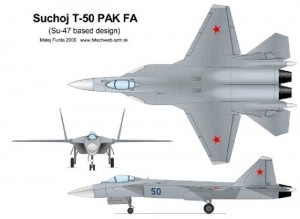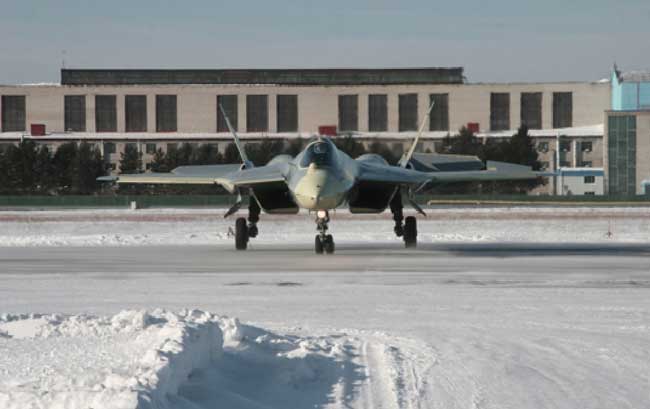
The United States possess the only fifth-generation fighter currently in service, the F-22A Raptor stealth fighter, which entered the U.S. Air Force in 1997. The Russian Federation is hoping to join this exalted category in the next few years, with its new fighter plane, which began public test flights earlier this year. The Russian Air Force hopes to begin flying the plane in 2015, the year it could enter serial production. But the Russian aerospace industry must still overcome certain residual barriers before the country will have a genuine fifth-generation fighter for domestic use and foreign export.
The T-50 represents the first prototype of Russia’s first declared fifth-generation multi-role fighter/attack plane. It is formally known as the Advanced Front-Line Aviation Complex (PAK FA), [Russian: Перспективный Авиационный Комплекс Фронтовой Авиации, Perspektivnyi Aviatsionnyi Kompleks Frontovoi Aviatsy, literally “Prospective (Promising) Aircraft Complex (System) of Front line Aviation”]. It is designed and manufactured by the state-owned OAO Sukhoi aircraft corporation, which won the initial tender for the plane in 2002. The first public test flight occurred on January 29, 2010, at a Sukhoi plant located at Komsomolsk-on-Amur in the Russian Far East.
Sukhoi has already built two other T-50 prototypes that are also participating in the first-phase of testing. The company has said that the plane will undergo a normal test pattern, which will result in the T-50 prototypes undergoing around 2,000 additional flights and other tests during the next few years at several Russian aviation research institutes. The first stage of government testing of these fifth-generation fighters will last into 2012. Second-stage testing will involve radio countermeasures and surveillance in “optical and infrared ranges and its weapons.” Russian Prime Minister Vladimir Putin said that the Lipetsk military airbase, 400 kilometers south of Moscow, would begin testing an evaluation unit quipped with the PAK FA fighters in 2013. Unless the tests expose unexpected problems, serial production of the new plane is scheduled to begin in 2015.In developing and manufacturing the PAK FA, Sukhoi has functioned as a systems integrator for more than a hundred suppliers and strategic partners, a difficult challenge now that the centralized Soviet planned economy is gone, even in the defense sector. The Tikhomirov Scientific Research Institute for Instruments (NIIP) has been developing the plane’s X-band nose-mounted Active Electronic Scanned Array (AESA) Radar. NIIP Director Yuri Belyy will “no longer be just radar, but an integrated radio-electronic system, which includes radars in several wave bands, an identification system, electronic warfare (EW) and electronic intelligence (ELINT).” The new fighter’s fire-control system will be designed on the basis of the Su-35BM’s systems.
The cost of developing the PAK FA will amount to some U.S. $8-10 billion dollars in total, if one includes the 250 planes the Indian government wants to acquire (and co-develop) as part of its “Fifth Generation Fighter Aircraft (FGFA) program. The Russian Air Force also wants to acquire around 250 of the planes. With a total production run of some 500 planes, this would render an average cost per plane of around $90-100 million each. Once the plane is deployed, the PAK FA is supposed to have a service life of 35 years.
Russian aircraft makers have been seeking to manufacture a fifth-generation warplane since the 1980s. The single-piloted, twin-engine Sukhoi PAK FA is intended to replace the aging fleets of Soviet-era MiG-29 Fulcrums and Su-27 Flankers. The Russian Air Force current possesses 300 of each plane. The new PAK FA planes will serve alongside the other main warplane Sukhoi has recently provided the Air Force, the Su-35s multi-role fighter. The Su-35 is considered a “four++” generation plane, with only some fifth-generation capabilities. The Russian Air Force plans to backload some of the new technologies developed for the PAK FA, especially the AESA Radar, as mid-life upgrades onto its existing Su-35BMs, Su-30MKIs, and Su-30MK2s
It is possible that Russia might seek to develop a naval and unmanned variant of the PAK FA in future years. Russia would also employ some of the new technologies on the next-generation long-range strategic bomber with stealth and other B-2 characteristics that Russia hopes to pursue through its PAK-DA program. On March 1, 2010, Prime Minister Vladimir Putin said the aim was to develop “an airborne missile-carrier.”
Russian strategists remain committed to having a nuclear triad of bombers along with ground- and submarine-launched missiles. A long-range bomber would also be useful for distant power projection as well as showing the flag, as Russia did in September 2008 by sending a pair of Tu-160 Blackjack bombers to Venezuela.
Front view of the aircraft (Credit Photo: http://www.defenceforum.in/forum/showthread.php/8276-PAK-FA-Post-First-Flight-Developments!-Putin-visits-PAK-FA?p=121035&viewfull=1)
A new strategic bomber would replace the three Soviet-era bomber types currently in service with Russia’s strategic aviation, the Tu-22M3, the Tu-95MC Bear, and Tu-160 Blackjack. The Tupolev aircraft maker said last year that a new-generation strategic bomber would be developed by 2017, while production should start in 2020 to 2025, though Maj. Gen. Anatoly Zhikharev, commander of Russia’s strategic aviation said a new strategic bomber expected to enter service in 2025 to 2030.
“Fifth-generation” planes have stealth (low-observable) characteristics, making them almost invisible to conventional radars. These attributes include using composite materials, emitting reduced engine heat, and employing other advanced technologies that minimize the plane’s optical, infrared, and radio-frequency visibility.
Fifth-generation warplanes also possess sophisticated advanced integrated weapons and navigation control systems that utilize the latest artificial intelligence. Furthermore, they can fly at sustained supersonic speeds [“supercruise”] of over 2,000 km/h. Most other planes can only attain such speeds for a limited time by using afterburners.
Russian officials have already hailed the fighter as “a unique warplane” that combines the
capabilities of an air superiority fighter and attack aircraft to give it enhanced combat effectiveness against air and ground targets around the clock in all meteorological conditions.
According to Sukhoi, the PAK FA will have a new advanced avionics suite integrating “electronic pilot” functionality; an advanced phased-array radar; more automatic controls that significantly decrease pilot load and allows him to focus upon completion of tactical missions; as well as new on-board equipment that allows realtime data exchange not only with ground-based control systems but also within the flight group.
Finally, it will have a very low radar cross-section thanks to its composites application and innovative technologies, aircraft aerodynamics, and measures applied to decrease the engine signature provide for the unprecedented small radar cross section in radar, optical and infrared range. In terms of armaments, the plane will be equipped with novel high-precision air-to-air, air-to-surface and air-to-ship missiles and two 30 mm cannons in order to enable it to function in multiple roles, including dog fighting other planes and striking multiple ground and maritime targets simultaneously.

In terms of dogfighting, the PAK-FA was specifically designed as an F-22 killer. Given that both planes will have stealth capabilities, the combatants might need to come very close before their radar sensors detect the other side. Since only the PAK-FA has an Infra-Red Scan and Track (IRST) sensor, it has a distinct advantage over the F-22A in a close engagement. Another potential advantage is that Sukhoi planes typically have a superior ability to operate at high angles of attack (AoA than their less agile American counterparts.
Yet, it is difficult to determine the actual capabilities of the PAK-FA T-50 because of conflicting information released by Sukhoi, Russian Air Force members, Putin, and other observers of this project. In addition, there is often a difference between desire and reality when it comes to Russian defense procurement. Russia must overcome several technical and performance obstacles in order for the Russian fighter to compete on a performance basis with the world’s pre-eminent fifth-generation fighter(s).
Despite claims by Russia’s NPO Saturn company, which leads the program to build new engines for the PAK FA, that the T-50 has flown its test flights with “completely new powerplants,” these statements are both unverified and seemingly contradicted by Russian government officials. The super-cruise engines intended for Russia’s fifth-generation fighters may not yet be available. Despite the development of Russian manufacturer NIIP of an active, electronically scanned array (AESA) radar system, similar to the system used by the F/A-22, for the PAK FA, it has not yet been seen on a test flight. This is a significant shortcoming in the development of the PAK FA as a modern stealth fighter, since stealth aircraft rely on their Low Probability of Intercept radar system for survival and their ability to “see and not be seen” gives such aircraft the ability to form a picture of their battlespace and gain air-to-air superiority.
It is unclear if the PAK FA can be completed in under 9 years. Historically, fourth- and fifth- generation fighters normally require 15 years or so to develop. The fact that the PAK FA has gone on several test flights without super-cruise engines or an LPI/AESA radar means that it is unlikely that the production goal of 1,000 operational ready PAK FAs will be ready by the stated 2015 date.
But funding and other support from the Indian government might help accelerate the timetable. India has become largest foreign customer for Russian military aircraft, and would be a logical buyer of this plane. In October 2007, Indian and Russian officials signed a preliminary agreement to collaborate in developing and manufacturing a 5th-generation fighter. The two governments are still negotiating a final contract. India’s Hindustan Aeronautics Ltd (HAL) wants to modify Sukhoi’s single-seat prototype into the twin-seat fighter.
There are too many unknown factors at this point to assess how well the PAK FA will fare against its only equivalent in the world, the F/A-22. Sukhoi have not been able to integrate supercruise engines or LPI radar into its tests flights as of yet, nor have they had any flight exercises beyond basic test flights.
In addition, the problems that Russia’s defense industry has experienced in developing and maintaining other sophisticated weapons systems, such as the Navy’s aircraft carriers and new Bulava submarine-launched ballistic missile, leave uncertain whether it can of manufacture and maintain a fleet of low-observable aircraft. Quality control at the level of sub-contractors has been a recurring problem challenging the reliability of Russian weapons systems.
Another challenge for Russia’s program is that Moscow’s defense priorities might change. The PAK FA is a high prestige program that is also seen as a means of helping to revitalize Russia’s military and civilian aerospace sectors. Yet, the main threats facing Russia today come from Islamist terrorists, which are best countered by good intelligence, local police work, and perhaps small-unit military action by Special Forces. Critics might succeed in inducing the Russian government to reallocate funds from the PAK FA program to other defense or civilian priorities. A related issue is that the Indian government might decide not to join with Russia in co-producing the plane and withdraws its funding.
Nonetheless, a cause of concern for U.S. analysts will be the increased spending in the Russian military budget, the will of the Russian government to push this product through and meet its 2015 deadline, and Moscow’s interest in selling the plane to other countries, which risks proliferating their fifth-generation technologies. The willingness of Russia to export a fifth-generation fighter with the ability to penetrate sophisticated air defenses is another issue of concern. In contrast, the number of F-22 planes to be produced is more strictly limited, meaning the PAK FA, while perhaps not being able to outperform the F/A-22 on a plane-by-plane basis, could outnumber U.S. fifth-generation fighters in coming years.
———-
***Posted on August 17th, 2010
———-
Appendix
Basic Information for the Sukhoi T-50: Estimated Performance
Dimensions (m): wing (14,2; S=78,8 m2); length (22); height (6, 05)
Weight (kg): max (37000); normal (26000); empty (18500)
Fuel (kg): 10300
Combat Load (kg): max (7500); AA max (2260) conformal
Speed (km/h): max (2100; m2, 0); rate of climb (350 m/s); min (0 OVT); cruise (1300)
Alt (m): 20000
Flight range (km): 4000/5500 (2x2000kg)
Supersonic (2500)
Runway (m): 350 (w/o OVT)
G-force (g): 10-11
RSC: 0,05 m2
Wing overload (kg/m2): max (470); normal (330)
Thrust to weight ratio: max (0,84); normal (1, 19)
Fuel rate: 2,55 kg/km
Flight time: 3,3 h
Engine: AL-41F (117C on first prototypes)
Thrust: 2×15500 (18000?/2×9800)
Compressor: diameter 932mm, 3 steps
Weight: 1350 kg
Pressure increase: 4,2-4,5
Life time: 4000 hours
Overhaul life: 1500 hours
Nozzle weight: 380 kg
Deviation angle: +16 deg in any direction, +20 deg flat
Deviation speed: 60 deg/sec
Electronics: N050 (?) BRLS IRBIS AFAR/AESA
Armament? 1(2?)X30mm gun
Harpoints: 10 (conf.), possible 2*4 external
[SOURCE: “PAK-FA Sukhoi T-50,” WARFARE.RU, Omsk VTTV Arms Exhibition, Military Parade JSC, 2010, http://warfare.ru/?linkid=2280&catid=255].
Comparison between Russia’s T-50 and the U.S.’s F-22 Raptor
- Cruising speed: T-50: mach 1.7-1.8; F-22: mach 1.7
- Maximum speed: T-50: mach 2.45; F-22: mach 2.5
- Range: T-50: 2,000 km; F-22: 2,000 km
- Service ceiling: T-50: 20,000m; F-22: 20,000m
- Maximum take-off weight: T-50: 37,000 kg; F-22: 38,000 kg”
- The T-50 will cost less than $100 million which is 2.5 times less than the Lockheed Martin/Boeing F-22
[SOURCE: “The T-50 Fifth Generation Fighter,” June 7, 2010, RIA Novosti, http://en.rian.ru/infographics/20100219/157939986.html.]


